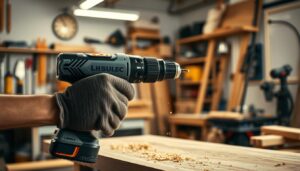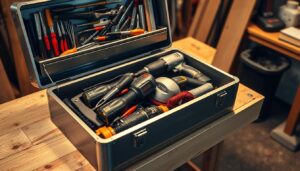Are you aware of the potential dangers associated with using an angle grinder? These versatile power tools are staples in both professional construction and DIY home projects, capable of cutting, grinding, and polishing various materials with ease.
However, their power and versatility come with significant risks. When mishandled, angle grinders can lead to serious injuries and accidents. It is crucial for both professionals and enthusiasts to understand the common hazards associated with these tools, including cuts, kickback, flying debris, and fire risks.
Understanding the proper safety measures is not just about preventing injuries; it also improves work quality and tool longevity. As we explore the essential knowledge required to operate angle grinders confidently and safely, you will learn how to harness their full potential while minimising risks.
Key Takeaways
- Understanding the versatility and potential hazards of angle grinders is crucial for safe operation.
- Proper safety knowledge is essential for preventing injuries and improving work quality.
- Familiarity with common hazards such as cuts, kickback, and flying debris can significantly reduce risks.
- Safe operation practices enhance tool longevity and overall work efficiency.
- Both professionals and DIY enthusiasts can benefit from learning essential safety measures.
Understanding Angle Grinders and Their Risks
To use an angle grinder safely, you must first comprehend its potential hazards. An angle grinder is a powerful power tool used for various tasks such as grinding, cutting, and polishing.
What is an Angle Grinder?
An angle grinder, also known as a disc grinder, is a versatile tool that is widely used in construction, metalworking, and fabrication. It consists of a motorized rotating disc that can be fitted with different types of abrasive discs or cutting wheels, making it suitable for a range of applications.
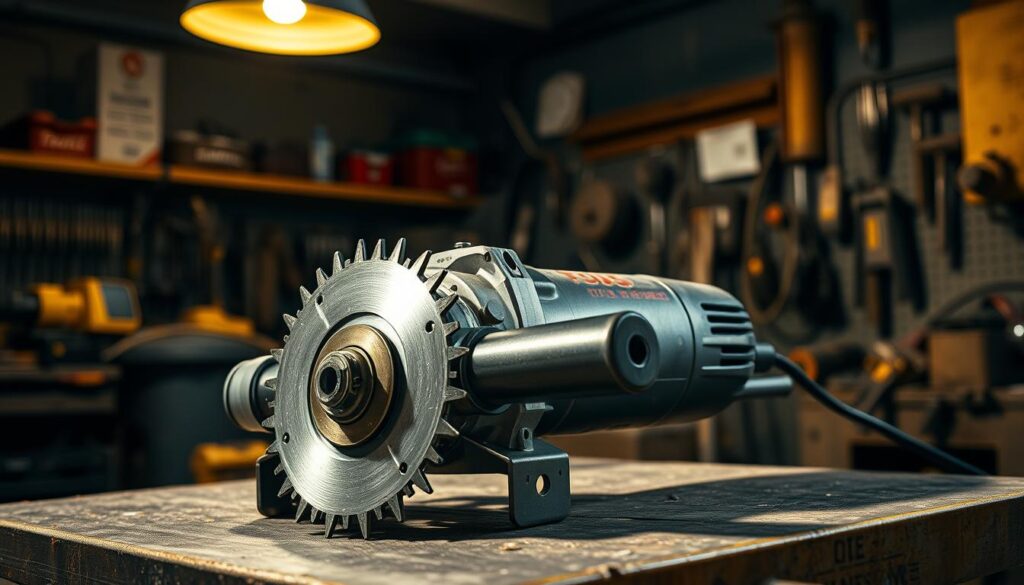
Common Hazards and Accident Statistics
Mishandling an angle grinder can lead to serious injuries, property damage, and even fatalities. Accident statistics reveal that nearly half of all accidents involving abrasive wheels are due to operator error or an unsafe system of work. Common hazards include cuts, amputations, eye injuries, and burns from sparks or flying debris.
The severity of these accidents can be significant, often requiring medical attention. Understanding these risks is the first step towards mitigating them effectively. By acknowledging the potential hazards associated with grinders, you can take necessary precautions to ensure a safe working environment.
Essential Angle-Grinder Safety Basics Before Operation
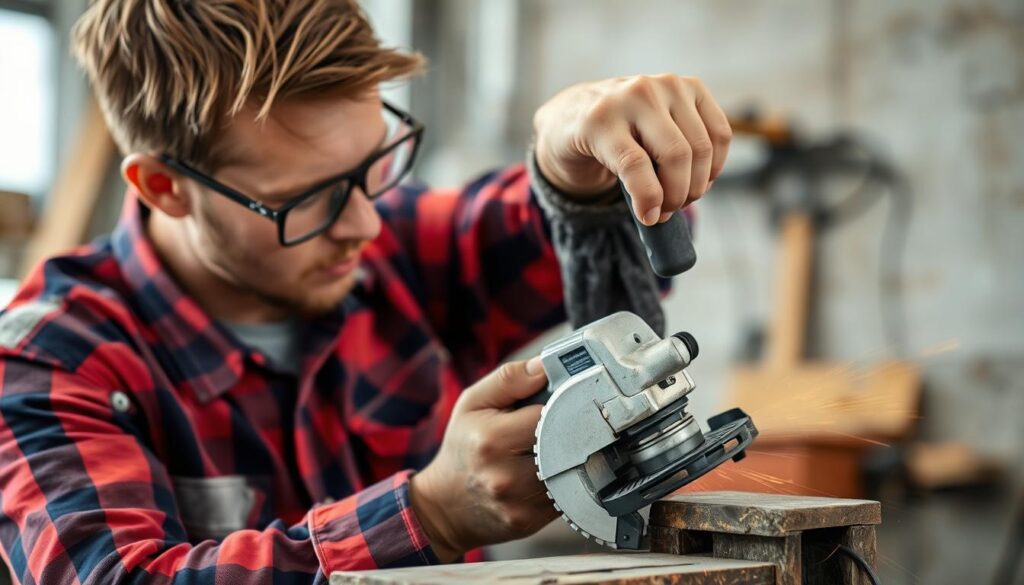
To ensure a safe working experience with your angle grinder, several key safety basics must be observed. Before you begin, it’s essential to inspect your tool and workspace to identify any potential hazards.
Inspecting Your Tool and Workspace
Inspecting your angle grinder and the workspace is a critical step in ensuring safety. Check your tool for any damage or wear, and ensure that the workspace is clear of clutter and tripping hazards. Verify that the work area is well-lit and free from flammable materials.
Selecting the Correct Disc for the Job
Selecting the correct disc for your angle grinder is vital for safe operation. Ensure that the disc is compatible with your grinder’s RPM and is suitable for the material you are working on. For example, use a diamond cutting disc for harder stone and a grinding wheel for grinding tasks. Always check the disc for damage before installation and store discs properly to maintain their integrity.
By following these essential safety basics, you can significantly reduce the risk of accidents when operating an angle grinder. Remember to always check the disc’s specifications and ensure it is properly secured before starting your work.
Personal Protective Equipment Requirements

To minimise risks associated with angle grinder use, it’s essential to wear appropriate personal protective equipment (PPE). PPE acts as a barrier between you and the hazards generated by the tool, significantly reducing the risk of injury.
Eye and Face Protection
Safety glasses or goggles are crucial for protecting your eyes from flying debris. A face shield can provide additional protection for your face.
Hearing Protection
Angle grinders can generate significant noise, making ear protection such as earplugs or earmuffs essential for preventing hearing damage.
Hand and Body Protection
Gloves can protect your hands from cuts and abrasions, while long sleeves and trousers can protect your skin from debris. Consider wearing protective clothing made from durable, cut-resistant materials.
Respiratory Protection
When working with materials that generate dust or fumes, respiratory protection is vital. Use a dust mask or respirator with the appropriate filter to protect your lungs. Be aware of the risks associated with silica dust, wood dust, and other harmful particulates. Consider using local extraction systems or dampening techniques to reduce airborne dust.
Proper Handling and Operation Techniques
To operate an angle grinder safely and effectively, it’s essential to understand the correct handling and operation techniques. This includes maintaining control during startup, positioning the tool correctly, and stopping it safely.
Two-Handed Operation for Maximum Control
Using both hands to operate the grinder provides maximum control and stability. Hold the tool with a firm grip, ensuring your hands are positioned to counteract the torque and potential kickback. This technique is crucial for maintaining precision and preventing accidents.
Correct Positioning and Angles
The correct positioning and angle of the angle grinder are vital for effective and safe operation. Ensure the disc is at the correct angle to the workpiece and that you are standing in a stable position, away from the line of potential kickback.
Starting and Stopping Safely
When starting the grinder, hold it away from your body and any materials until it reaches full speed. As emphasised by safety guidelines, “Don’t apply the angle grinder to any material until it’s up to full speed to avoid grabbing and kickback.” When stopping, release the trigger and maintain a firm grip until the disc comes to a complete stop. Always wait for the disc to stop rotating before setting the tool down.
By following these guidelines, you can significantly reduce the risk of accidents and ensure a safe working environment when using an angle grinder.
Disc Management and Maintenance

The safety of your angle grinder depends significantly on how you manage its discs. Proper disc management is not just about replacing worn-out discs; it’s about ensuring that every aspect of disc handling, from installation to disposal, is done with safety in mind.
Ensuring Discs are Properly Secured
To prevent accidents, it’s crucial that discs are properly secured on your angle grinder. This involves checking that the disc is correctly fitted and that all securing nuts and flanges are tightened according to the manufacturer’s specifications. A properly secured disc reduces the risk of it coming loose during operation, which could lead to serious injury.
Safe Disc Replacement Procedures
When replacing discs, always unplug the angle grinder or remove the battery to prevent accidental start-ups. Inspect new discs for damage before installation, and ensure they are compatible with your grinder and the task at hand. Handle discs carefully to avoid contamination and damage, and follow the manufacturer’s instructions for reassembly. Finally, test the grinder at a safe distance before commencing work.
Environmental Safety Considerations
Ensuring a safe working environment is paramount when using an angle grinder, as it involves managing dust, ventilation, and other environmental factors. You must be aware of the potential hazards associated with your work environment to prevent accidents and ensure a healthy workspace.
Working in Non-Flammable Areas
When operating an angle grinder, it is essential to work in well-ventilated areas that are free from flammable materials. Sparks generated during grinding can ignite nearby combustible materials, leading to fires. Ensure your workspace is clear of such hazards to prevent fire accidents.
Proper Ventilation and Dust Control
Check the ventilation of your workspace to prevent dust and vapor from drifting around the room and being inhaled. You should be aware of dust exposure, especially from silica, wood, and other harmful materials. Dampening down at the source and wearing a dust mask can protect your lungs. Proper ventilation, including natural airflow and extraction systems, is crucial for minimizing airborne particulates. Positioning yourself to avoid breathing in dust and fumes, and using dust suppression techniques like water damping for masonry work, are effective strategies. Additionally, setting up temporary containment systems in enclosed spaces can prevent dust from spreading.

Preventing Common Angle Grinder Accidents
Preventing accidents with angle grinders involves understanding the risks and taking appropriate safety measures. Many angle grinders are electric, so you should consider accidents caused by portable electrical equipment too.
Avoiding Kickback Incidents
Kickback occurs when the grinder is pinched or caught, causing it to jerk back towards the operator. To avoid this, maintain a firm grip with both hands, ensure the work area is clear, and never pin the grinder against the workpiece.
Preventing Entanglement Hazards
Entanglement can happen when loose clothing or long hair gets caught in the grinder. To prevent this, wear fitted clothing, tie back long hair, and avoid wearing loose jewellery that could get entangled.
Electrical Safety Measures
To ensure electrical safety, visually inspect the tool before use, have periodic portable appliance testing, and route cables away from the wheel to avoid contact. Use RCD protection when operating in damp environments or outdoor settings, and ensure proper voltage matching between the tool and power supply.
Regular PAT testing for electric angle grinders used in professional settings is also crucial. Consider using battery-powered angle grinders in situations where electrical hazards are a concern.
Advanced Safety Features in Modern Angle Grinders
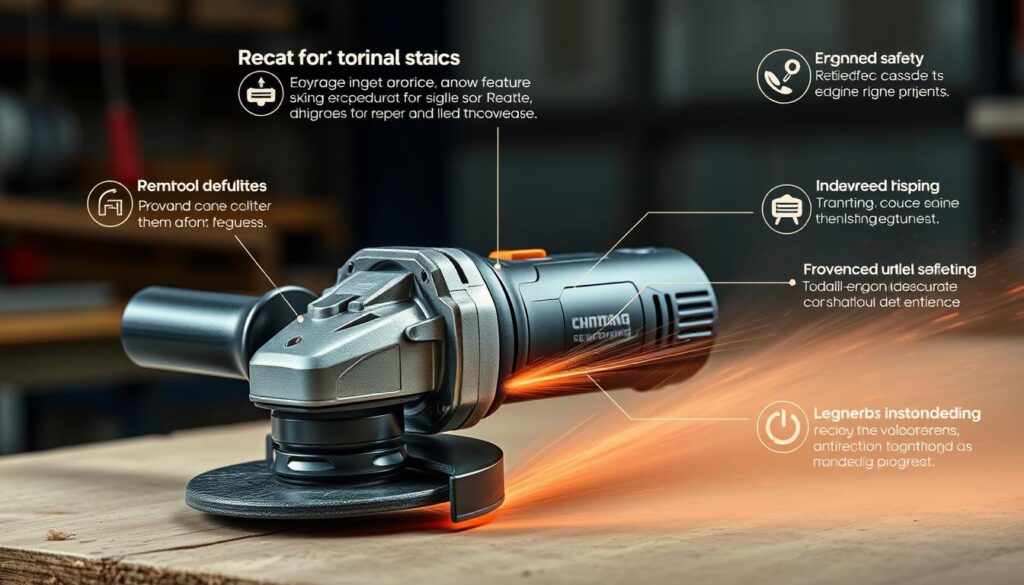
Modern angle grinders have evolved to incorporate advanced safety features that significantly reduce the risk of accidents. You can now benefit from these enhanced safety features when using angle grinders.
Brake Technology and Anti-Restart Protection
Modern angle grinders often come equipped with brake technology that stops the disc quickly when the tool is switched off, reducing the risk of injury. Anti-restart protection prevents the tool from starting unexpectedly after a power interruption, ensuring your safety during operation.
Electronic Clutch Protection and Non-Removable Guards
Electronic clutch protection minimises kickback when a disc jams during a cut, instantly detecting the jam and cutting power to the motor. For instance, Makita was the first company to release angle grinders with non-removable guards, which maintain protection while offering tool-free adjustment for different applications. To learn more about using angle grinders safely, visit https://www.protoolreviews.com/how-to-use-an-angle-grinder/.
The evolution of guard design has led to the development of quick-guard rotation systems, allowing you to reposition guards for optimal protection without compromising workflow or requiring additional tools. These advanced safety features are increasingly becoming standard on professional-grade grinders, enhancing protection and reducing workplace accidents.
Conclusion: Prioritising Safety for Effective Angle Grinder Use
To ensure you’re using your angle grinder safely and efficiently, it’s vital to grasp the fundamental safety principles. By prioritising angle grinder safety, you not only prevent injuries but also enhance your work quality.
Implement these angle-grinder safety basics immediately in your work practices and share this knowledge with colleagues and apprentices to foster a safer working environment.


